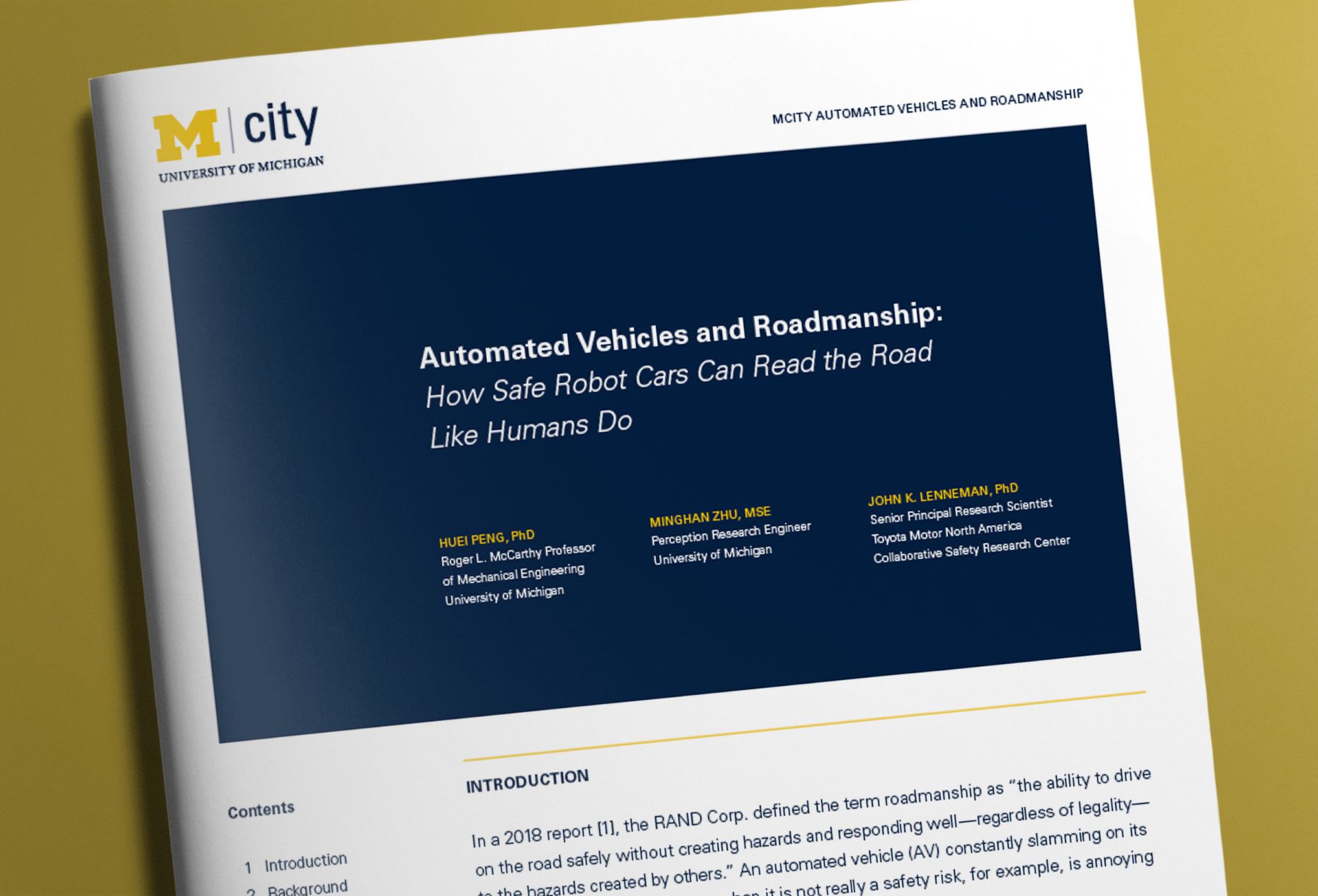Designing AVs to be safe, courteous starts with understanding how people think when they’re behind the wheel

Mcity and Toyota team up to study how data collected from real-world driving could help AVs learn to seamlessly share the road with human drivers
Automated vehicles will have to manage all the same driving situations as vehicles driven by humans, and do so safely and courteously, especially as AVs and human-driven vehicles are expected to share the road for a long time to come.
An AV slamming on its brakes again and again to avoid obstacles, even when there is no safety risk, for example, would potentially create a safety hazard for other vehicles.
Avoiding this scenario exemplifies a concept known as roadmanship. But how is roadmanship measured? And can AVs be taught desirable roadmanship?
The first step is to better understand how humans drive.
Mcity at the University of Michigan, a public-private partnership focused on advanced mobility, today published a white paper based on research conducted with Toyota Motor North America’s Collaborative Safety Research Center that defines a process to quantify roadmanship by using naturalistic driving data, which means the data was collected from real-world, every-day driving situations.
”Realizing the potential benefits of widespread adoption of vehicles with a high level of automations — or fully autonomous — requires winning public trust in AV technologies,” said Mcity Director Henry Liu, who is also professor of Civil and Environmental Engineering, research professor at the U-M Transportation Research Institute, and director of the Center for Connected and Automated Transportation. “Can AVs be driven like human drivers? One element of intelligent driving is roadmanship.”
The research team studied “gap acceptance” decisions made by human drivers in two scenarios: at a roundabout and at an intersection where left turns across lanes were not controlled by a traffic signal.
“These scenarios were chosen because they exemplify common “gap acceptance” behavior, which is one of the most important roadmanship decisions we face every day on the road,” said Huei Peng, lead researcher on the project for U-M, Roger L. McCarthy Professor of Mechanical Engineering, and former director of Mcity.
“Realizing the potential benefits of widespread adoption of vehicles with a high level of automation – or fully autonomous – requires winning public trust in AV technologies. Can AVs be driven like human drivers? One element of intelligent driving is roadmanship.”
Henry Liu, director of Mcity
Data was collected from a 24/7 livestream video of one intersection in Jackson Hole, Wyoming, totalling more than 5,000 accepted or rejected gaps, including 3,000 during good weather, and 2,000 on snowy days. More than 22,000 data points were collected at roundabouts, including 9,000 during normal weather, 9,000 on rainy days, and 4,000 on snowy days.
If enough naturalistic driving data is collected, it can be used to guide the decision-making process of an AV so that its behavior is statistically indistinguishable from vehicles driven by human drivers under similar situations, according to the white paper. The AV will literally be indistinguishable from other human-driven vehicles.
This is important today because most vehicles are operated by human drivers. As AVs achieve higher market penetration, it is expected they will perform better than human drivers. During the transition, establishing a clear definition of, and maintaining desirable, robust roadmanship is essential.
“As vehicle automation is introduced over the coming years, it’s important that the automation is integrated into a mixed automation and human-driving society as seamlessly as possible,” said John Lenneman, senior principal research scientist at the Collaborative Safety Research Center, who worked with U-M’s Peng.
“We need to understand not just how humans drive to be safe,” he said. “We also need to understand how humans drive to be courteous to others. Ultimately we hope automated vehicles have the same sense of courtesy you expect from the best human drivers.”
The Mcity-Toyota team found the most important factor in gap acceptance for human drivers at the intersection they studied was the distance between vehicles, not the time gap that separates them, as is often hypothesized. For the roundabouts studied, however, the time gap was more important.
“We need to understand not just how humans drive to be safe. We also need to understand how humans drive to be courteous to others.”
John Lenneman, senior principal research scientist, Toyota Motor North America Collaborative Safety Research Center
Why the difference? The researchers believe it may be that human drivers can accurately estimate distance in both scenarios. Humans are also good at estimating speed in a roundabout as another vehicle crosses their field of view. But speed is harder for human drivers to estimate while waiting to make a left turn at an intersection because the oncoming vehicle “looms larger” as it travels directly toward them.
Lenneman said the research team learned much about how humans drive in “just the smallest sliver of scenarios” where roadmanship comes into play.
“In order to gain a complete picture of roadmanship,” he continued, “It’s going to take a lot of bright minds over quite a bit of time, which is why we’re excited that we’ve established the relationship with Mcity as we try to address this up and coming issue.”
Toyota is a member of Mcity’s Leadership Circle of industry partners.
The white paper is titled, “Automated Vehicles and Roadmanship: How Safe Robot Cars Can Read the Road Like Humans Do.”